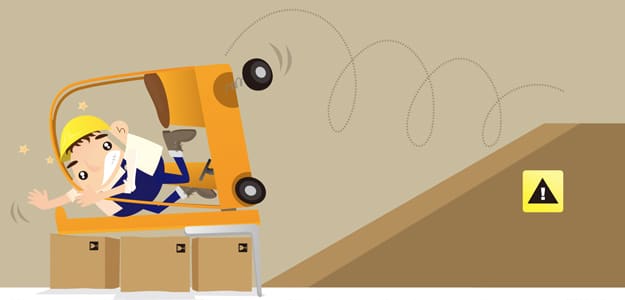
10 Forklift Safety Mistakes to Avoid
October 6, 2015 | Staffing Blog
Operating machinery isn’t as easy as it looks. However, it is easy to make mistakes when you aren’t knowledgeable on the machinery you’re operating or you’re simply fooling around. While there are several things you should avoid doing when using a forklift, here are 10 Forklift Safety Mistakes to keep in mind.
1. A long day at work will leave you tired and in pain. It is absolutely important to not operate a forklift – or any machinery for that matter – if you are overly tired or on medication that can cause drowsiness. Keep yourself and coworkers free from injury by ensuring that you are properly focused.
2. If you’re working in a warehouse, it’s more than likely that you’ll need to pass another forklift in front of you. Passing at blind spots or intersections can make driving more difficult. Proceeding slowly and warning others of your presence is a safe practice that should be adopted if it hasn’t been already.
3. Driving a forklift does not mean you have the right-of-way. Pedestrians always come first. The only place you should be looking when driving a forklift is in front of you. Avoid driving up to pedestrians that are in front of an object. If the forklift loses control or starts to tip, pinning the person between the machine and the object could result in injury or even death.
4. Ensuring that your forklift won’t tip over will prevent fatal accidents. Keeping the forks low and mast titled back slightly while the forklift is moving can help. Loads that are too tall or top-heavy can contribute to the likelihood that the forklift will tip. Making turns too fast can also result in the forklift tipping over as well as turning on a grade.
5. If you are driving a gasoline or propane forklift, keeping track of time is essential to preventing carbon monoxide reaching unsafe levels.
6. Forklifts become unstable when driven at a fast speed. Speed combined with top-heavy loads or limited driving space will put you and your coworkers at risk for injury. As a rule of thumb, forklifts should be driven as fast as a person can walk.
7. Surface conditions are just a few causes of forklift accidents. Don’t make the mistake of driving on oil slicks, water, ice, or snow if you can avoid it altogether. Uneven ground and pot holes can wreak havoc as well. Staying alert and driving at a controllable speed will make these obstacles easier to avoid.
8. On top of the fact that forklift operators should be alert for surface conditions, it is possible that liquids could be flammable. Driving around unknown liquids or completely avoided that area until you know exactly what it is will prevent damage to the forklift and injury to everyone involved.
9. Should you encounter a ramp, forklift operators should always back down a ramp. Keeping the slope in mind is also helpful. For inclines that are steeper than most, loads should be carried upgrade.
10. Joy rides are one thing that operators have complete control over. Forklifts are meant for the driver and their load. It’s quite easy for riders to fall off the forklift, worsening any possible forklift accident.
There are several individual factors that can contribute to forklift accidents, even more so when they are in combination. Forklifts can tip over even when there is no load. Safe driving practices are just as important to forklift accident prevention as carrying a load is.
For more information on safe practices in your industry, contact us today.
